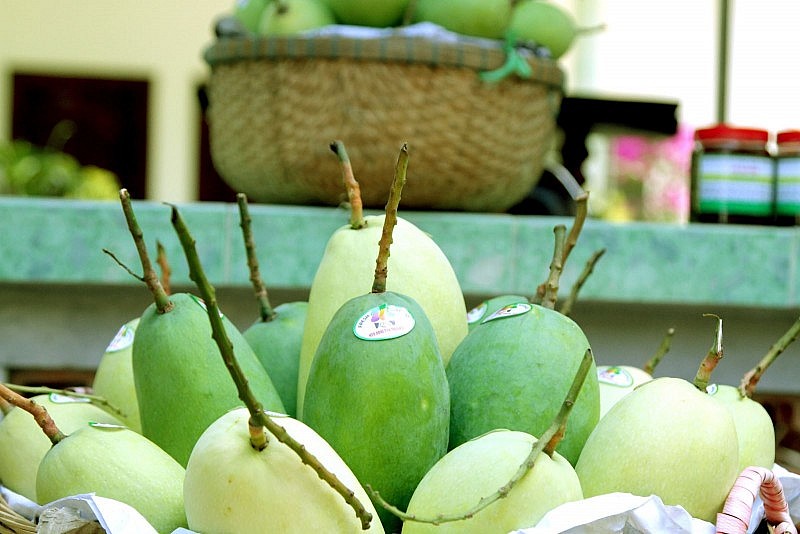 News
News
Vietnam has become the 13th largest mango exporter in the world. Vietnamese mangoes have been exported to 40 countries, in which, the main market is China, accounting for nearly 84.6%; followed by Russia, the United States, Korea, EU, Australia, Japan... However, Vietnam's mango export turnover accounts for just over 1% of the total world mango exports.
 |
| Vietnam's mango exports account for just over 1% of the world's total mango exports |
With the development of the global economy, it is extremely necessary to find export markets for Vietnamese agricultural products in general and mangoes in particular, as well as strengthen trade relations with international partners. In addition, it is necessary to comply with the phytosanitary regulations of export markets.
Mr. Luong Ngoc Quang - Department of International Cooperation and Communication (Department of Plant Protection - Ministry of Agriculture and Rural Development) - said: For mangoes exported to WTO countries, the regulations must be complied with. phytosanitary provisions of the Agreement on Sanitary and Phytosanitary Measures (SPS Agreement) and the International Convention on Plant Protection - IPPC.
The basic requirement for fresh fruit products is to have a phytosanitary certificate issued by a competent authority and that the consignment is not contaminated with plant quarantine objects. Some import markets only need to meet the above basic requirements, including: Middle East countries, Eastern European countries, ASEAN countries and Canada.
According to Mr. Luong Ngoc Quang, in order to meet the regulations set forth by the importers, first of all, growers or packing establishments need to register the code of the growing area or packing facility. The registration of the growing area code or the code of the packing establishment on a voluntary basis, from which the Plant Protection Department inspects and evaluates, is the basis for granting a code or maintaining or restoring the code and must be approved by the Plant Protection Department. recognized by the importing country.
“The prerequisite when exporting mango is traceability. Particularly in the Mekong Delta, there are now nearly 300 planting area codes issued for export," said Mr. Luong Ngoc Quang.
For the Chinese market , Ms. Luong Thi Hai Yen - Plant Protection Department - said that now, the Chinese importer has made requirements on very high food safety assurance conditions, businesses must has a food safety management system equivalent to the HACCP standard. This requirement is difficult for small and medium enterprises to meet immediately.
In the most difficult market segment in the world, Mr. Tran Van Cong - Vietnam Agricultural Counselor in Europe - shared, the EU market is very potential. In 2022, they spend 35 billion USD to import fruit, of which 500,000 - 600,000 tons of mango are imported. However, the main import markets of the EU are Africa and South America. Mango of Vietnam in particular and Asia in general account for a very small proportion.
Despite the tax advantages, however, Vietnamese mangoes have not been able to penetrate deeply into their mass market because of the long distance (long transportation time, high cost), and short storage time. The cost of shipping by air is very high, so the ability to transport large quantities is very difficult.
In addition, in terms of quarantine, Europe sets very strict food safety criteria and pesticide residue thresholds. In addition, this market also has very different requirements for safety certification, environmental and social standards than before.
Vietnamese mangoes in the EU market are very potential, in which the Netherlands is the largest import market. Mr. Tran Van Cong recommended that businesses should prioritize developing high-segment mangoes, serving the Asian community in Europe. At the same time, it is necessary to pay attention to the introduction and promotion of Vietnamese mangoes. Currently, I have not seen any information about Vietnamese mangoes in the European market.
In 2015, Japan allowed the import of fresh Vietnamese mangoes. After many years of exporting, many Japanese consumers know about Vietnam's Cat Chu mango. This is a fragrant mango, green to yellow skin, tear-like shape and high sugar content, loved by Japanese people.
However, the market share of Vietnamese mangoes in the Japanese market is still modest. Vietnamese mangoes exported to the Japanese market are priced at 370 yen/kg (more than 600,000 VND/kg), only half that of Thai mangoes at 765 yen/kg.
Mr. Ta Duc Minh - Commercial Counselor of the Vietnamese Embassy in Japan - said that Vietnam has a lot of opportunities to boost the export of fresh mangoes to Japan when this market only accepts the import of mango varieties. Cat Chu and may expand its market share if Vietnam can negotiate to expand exports of other mango varieties in the future. In particular, the E2R2 mango - Australian mango is very suitable for the tastes and consumption habits of Japanese consumers.
Giving recommendations to exporters, Mr. Ta Duc Minh said that Japanese importers always want stability in prices and supply from Vietnamese export partners. This is also a market that requires high standards for product quality and food safety.
Therefore, businesses need to implement a synchronous link from growing, handling, preserving, transporting and exporting to strictly control quality and food safety standards, traceability, ensure the fruit must be fresh, keep the quality, the brand name and keep the market.